
A pie is a baked dish which is usually made of a pastry dough casing that contains a filling of various sweet or savoury ingredients. Sweet pies may be filled with fruit, nuts, fruit preserves, brown sugar, sweetened vegetables, or with thicker fillings based on eggs and dairy. Savoury pies may be filled with meat, eggs and cheese or a mixture of meat and vegetables.

Gnocchi are a varied family of dumpling in Italian cuisine. They are made of small lumps of dough, such as those composed of a simple combination of wheat flour, potato, egg, and salt. Variations of the dish supplement the simple recipe with flavour additives, such as semolina flour, cheese, breadcrumbs, cornmeal or similar ingredients, and possibly including herbs, vegetables, and other ingredients. Base ingredients may be substituted with alternatives such as sweet potatoes for potatoes or rice flour for wheat flour. Such variations are often considered to be non-traditional.
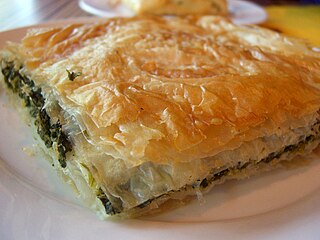
Savory spinach pie is a pastry eaten throughout the Balkans. The filling is made of chopped spinach and usually feta or white cheese, and egg.
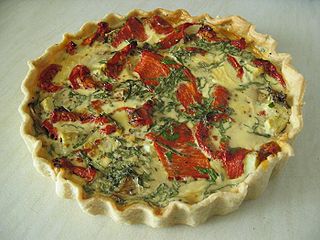
Quiche is a French tart consisting of pastry crust filled with savoury custard and pieces of cheese, meat, seafood or vegetables. A well-known variant is quiche lorraine, which includes lardons or bacon. Quiche may be served hot, warm or cold.
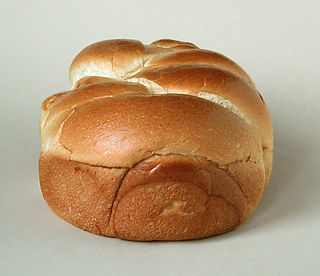
Brioche is a pastry of French origin whose high egg and butter content gives it a rich and tender crumb. The chef Joël Robuchon described it as "light and slightly puffy, more or less fine, according to the proportion of butter and eggs". It has a dark, golden, and flaky crust, frequently accentuated by an egg wash applied after proofing.

Quiche Lorraine is a French tart with a filling made of cream, eggs, and bacon or ham, in an open pastry case. It was little known outside the French region of Lorraine until the mid-20th century. As its popularity spread, nationally and internationally, the addition of cheese became commonplace, although it was criticised as inauthentic. The dish may be served hot, warm or cold.
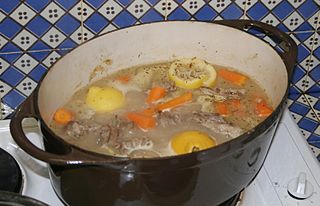
Blanquette de veau is a French veal stew. In the classic version of the dish the meat is simmered in a white stock and served in a sauce velouté enriched with cream and egg. It is among the most popular meat dishes in France.

Pâté is a forcemeat. Originally, the dish was cooked in a pastry case; in more recent times it is more usually cooked without pastry in a terrine. Various ingredients are used, which may include meat from pork, poultry, fish or beef; fat, vegetables, herbs, spices, wine and brandy.
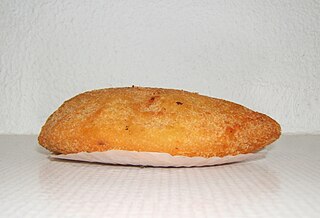
A rissole is a small patty enclosed in pastry or rolled in breadcrumbs, usually baked or deep fried. The filling has savory ingredients, most often minced meat, fish or cheese, and is served as an entrée, main course, or side dish.
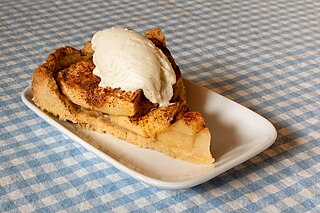
Apple cakes are cakes in which apples feature as a main flavour and ingredient. Such cakes incorporate apples in a variety of forms, including diced, pureed, or stewed, and can include common additions like raisins, nuts, and 'sweet' spices such as cinnamon or nutmeg. They are a common and popular dessert worldwide, thanks to millennia of apple cultivation in Asia and Europe, and their widespread introduction and propagation throughout the Americas during the Columbian Exchange and colonisation. As a result, apple desserts, including cakes, have a huge number of variations.

Galette is a term used in French cuisine to designate various types of flat round or freeform crusty cakes, or, in the case of a Breton galette, a pancake made with buckwheat flour usually with a savoury filling. Of the cake type of galette, one notable variety is the galette des Rois eaten on the day of Epiphany. In French Canada the term galette is usually applied to pastries best described as large cookies.

An éclair is a pastry made with choux dough filled with a cream and topped with a flavored icing. The dough, which is the same as that used for profiterole, is typically piped into an oblong shape with a pastry bag and baked until it is crisp and hollow inside. Once cool, the pastry is filled with custard, whipped cream or chiboust cream, then iced with fondant icing. Other fillings include pistachio- and rum-flavoured custard, fruit-flavoured fillings, or chestnut purée. The icing is sometimes caramel, in which case the dessert may be called a bâton de Jacob. A similar pastry in a round rather than oblong shape is called a religieuse.

Gözleme is a savory Turkish stuffed turnover. The dough is usually unleavened, and made only with flour, salt and water, but gözleme can be made from yeast dough as well. It is similar to bazlama, but is lightly brushed with butter or oil, whereas bazlama is prepared without fat. The dough is rolled thin, then filled with various toppings, sealed, and cooked over a griddle. Gözleme may sometimes be made from prepackaged hand-rolled leaves of yufka dough.

Gratin is a culinary technique in which an ingredient is topped with a browned crust, often using breadcrumbs, grated cheese, egg or butter. The term may be applied to any dish made using this method. Gratin is usually prepared in a shallow dish of some kind. A gratin is baked or cooked under an overhead grill or broiler to form a golden crust on top and is often served in its baking dish.

A gougère, in French cuisine, is a baked savory choux pastry made of choux dough mixed with cheese. There are many variants. The cheese is commonly grated Gruyère, Comté, or Emmentaler, but there are many variants using other cheeses or other ingredients.

Chouquettes or petits choux are small pieces of French patisserie consisting of small spheres of choux pastry, sugared and baked. The term was known in the 16th century, and was originally applied to small savoury spheres. Since the late 17th century choquettes have been sweet.

Tarte à l'oignon or Zewelwaï is a savoury tart with a baked filling of onions and cream. It is a speciality of the French region of Alsace, and may be served hot, warm or at room temperature. It is typically served as a starter.

















